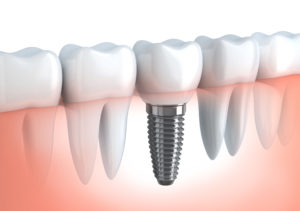
For many individuals who wish to replace one or more missing teeth, dental implants have become the leading preference in restoring biting and chewing strength and stability. Dental implants also help to prevent bone shrinkage that occurs when natural tooth roots are no longer present in the jaw bone.
Our goal is to help you have a successful outcome when dental implants are involved. When there are individual habits or preferences that can complicate success, we work proactively with each patient to reduce any risk factors before implant treatment begins.
For example, we advise smokers on ways to support saliva flow and minimize oral bacteria levels. For people who take certain medications that can interfere with oral moisture, we recommend methods to keep the mouth properly hydrated. And so on. We want to make sure your care is individualized so your potential for implant success is at an optimal level.
Dental implants come in a wide array of shapes and sizes. Each system is designed to accommodate certain needs and preferences. For example, some implants are designed to support a full arch of teeth while others can be placed in areas where a great deal of bone loss has occurred. The selection of the implant type that is appropriate for your needs and goals requires an experienced dental office that understands the implant type that can work best for you.
Before placement, however, and before selection, it is important to understand the unique aspects of the individual and their oral health so treatment can be planned with ultimate success in the forefront.
This is why foreseeing the risk factors involved, such as those with bone loss or having a dry mouth, can end up enhancing the long term outcome. For some patients, we know that proper bite is one aspect – an important one – of optimal treatment. It is not uncommon for bite misalignment or TMJ disorders to be at the precipice of implant failure.
When teeth are not working together in a healthy bite, it can cause strain on the jaw joints. The temporomandibular joints, or jaw joints,’ lie on each side of the head just in front of the ears. They function as hinges that connect the lower jaw to the skull. Movement is frequent and bite misalignment can trigger a domino effect of problems that ultimately extends to the these busy joints.
No part of the body is okay with being in discomfort. Known as bruxing, the jaw can subconsciously seek out a comfortable resting position during sleep. However, this motion can become an extreme action. For most people grind or clench their teeth, the force becomes more and more severe over time. Some people even clench with such force that it can crack a walnut.
Telltale signs of teeth grinding are abnormal tooth wear. Although malocclusion can cause chipped or broken teeth, worn teeth are a clear cut sign of bruxsing. This is where the tops of teeth flatten and become gradually shorter.
Think of filing your nails once a week. This keeps them to a desirable height and shape. Yet, if you filed them, with force, every day, you would wear them down to an uncomfortable level.
As teeth are worn down, it can wear tooth structure down to levels that expose the tooth’s interior, leading to the need to crown teeth. If protection to the tooth structure is not taken, it can lead to eventual tooth loss.
The complexity caused by clenching or grinding teeth when it comes to implant placement are destructive. First, this action interferes with the ability of the implant to properly heal. When healing time takes longer, the risk for bacterial penetration to the implant site(s) increases. Bacteria that reach this level are difficult to treat, which allows it to spread further.
Additionally, the life of an implant can be compromised because of bruxing. Imagine a nail driven into a wooden board that extends a bit out of a board in which it is hammered. If the protruding portion of the nail was pushed on, back and forth, for a time period each day, it would begin to loosen. Eventually, it would loosen to the point of being loose and removable.
Bite misalignment can also cause teeth to lean or tilt out of their proper positions. This allows the gums to release their tight seal around the base of teeth. This seal is what protects the vulnerable area of sensitive tooth roots from bacterial penetration. When a misaligned tooth adjacent to a dental implant opens up gum tissues to bacteria, the area surrounding the implant can be at higher risk of infection.
If you’ve considered dental implants to replace missing teeth, let’s discuss how our Shelby Township dental office can enhance your potential to enjoy confident smiles and chewing comfort – for your lifetime! Call 586-739-2155 or tap here to schedule a free consultation appointment. During this time, we can discuss recommended treatment, costs and payment plans, and oral and IV sedation options for enhanced comfort throughout your care.